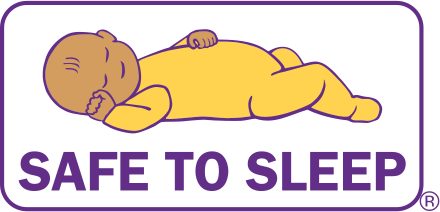Sudden Infant Death Syndrome (SIDS)
Sudden Infant Death Syndrome (SIDS), also known as cot death or crib death, refers to the sudden unexplained death of an infant less than one year of age. This condition usually occurs during sleep, predominantly between midnight and 9:00 a.m., and remains unexplained even after a thorough investigation, including an autopsy and detailed death scene examination. SIDS is the leading cause of infant mortality in Western countries, accounting for about half of all post-neonatal deaths.

Signs & Symptoms
SIDS typically affects infants between one to four months of age, with a peak incidence at two to four months. The condition is characterised by a sudden death during sleep without any preceding symptoms or signs of struggle. Infants usually do not exhibit any noise or alarm before the event.
Diagnosis
Diagnosing SIDS involves a meticulous process of exclusion. The diagnosis is confirmed when an infant's sudden and unexpected death remains unexplained after:
- Autopsy by an experienced paediatric pathologist.
- Investigation of the death scene and circumstances.
- Exploration of the infant's and family's medical history.
Some cases initially diagnosed as SIDS may be later attributed to suffocation, hyperthermia, hypothermia, neglect, or other defined causes.
Risk Factors
Although the exact cause of SIDS is unknown, several risk factors have been identified. These include:
- Sleeping Position: Placing infants to sleep on their stomachs or sides increases the risk.
- Overheating: Elevated or reduced room temperature, excessive bedding, and clothing.
- Exposure to Tobacco Smoke: Maternal smoking during pregnancy and postnatal exposure to smoke.
- Bed Sharing: Sharing a bed with parents or siblings, especially under unsafe conditions such as soft mattresses or when bed partners are under the influence of drugs or alcohol.
- Preterm Birth and Low Birth Weight: These factors significantly increase the risk of SIDS.
Prevention
The most effective preventive measure is to place infants on their back to sleep. Other recommendations include using a firm mattress without loose bedding, maintaining a cool sleeping environment, room-sharing without bed-sharing, and promoting breastfeeding and immunisation.

Epidemiology
Globally, SIDS accounted for about 19,200 deaths in 2015, down from 22,000 deaths in 1990. The incidence varies significantly across different populations, with rates ranging from 0.05 per 1000 in Hong Kong to 6.7 per 1000 among Native Americans. In the United States, SIDS was responsible for approximately 0.54 deaths per 1,000 live births in 2005, with a marked decrease in SIDS deaths from 4,895 in 1992 to 2,247 in 2004.
Genetics and Other Factors
Genetic predispositions play a role in SIDS, with a consistent 50% male excess in cases. About 10-20% of SIDS cases may be attributed to channelopathies, which are genetic defects affecting heart function. Other factors such as parental alcohol consumption, cold weather, and certain infections like Staphylococcus aureus and Escherichia coli have also been linked to SIDS.
Differential Diagnosis
Conditions that can mimic or coexist with SIDS include medium-chain acyl-coenzyme A dehydrogenase deficiency (MCAD deficiency), infant botulism, long QT syndrome, and bacterial infections like Helicobacter pylori. Child abuse, particularly forms involving suffocation, can also be misdiagnosed as SIDS.
Public Health Initiatives
Public health campaigns such as the "Safe to Sleep" campaign in the United States have significantly reduced the incidence of SIDS by promoting safe sleeping practices. Educational efforts have focused on encouraging parents to place infants on their backs to sleep and avoiding bed-sharing and exposure to tobacco smoke.

Socioeconomic and Cultural Factors
The rate of SIDS varies among different ethnic and socioeconomic groups, with higher rates observed in populations with lower socioeconomic status, less maternal education, and higher prevalence of smoking. Cultural practices also influence the incidence of SIDS, with certain practices either increasing or decreasing risk.
In summary, SIDS remains a very important area of concern in paediatrics, with ongoing efforts to understand its causes, improve diagnostic accuracy, and implement effective prevention strategies.
Self-assessment MCQs (single best answer)
What is the peak incidence age range for Sudden Infant Death Syndrome (SIDS)?
Which of the following is NOT a recommended preventive measure for SIDS?
Which risk factor is associated with an increased risk of SIDS?
Which diagnostic step is NOT part of the process to confirm a case of SIDS?
In which time frame do most SIDS cases occur?
What is the primary aim of the "Safe to Sleep" campaign?
Which of the following populations has the highest documented incidence rate of SIDS?
Which genetic condition is linked to approximately 10-20% of SIDS cases?
Which of the following factors is NOT associated with an increased risk of SIDS?
Which bacterial infections have been linked to SIDS?
Dentaljuce
Dentaljuce provides Enhanced Continuing Professional Development (CPD) with GDC-approved Certificates for dental professionals worldwide.
Founded in 2009 by the award-winning Masters team from the School of Dentistry at the University of Birmingham, Dentaljuce has established itself as the leading platform for online CPD.
With over 100 high-quality online courses available for a single annual membership fee, Dentaljuce offers comprehensive e-learning designed for busy dental professionals.
The courses cover a complete range of topics, from clinical skills to patient communication, and are suitable for dentists, nurses, hygienists, therapists, students, and practice managers.
Dentaljuce features Dr. Aiden, a dentally trained AI-powered personal tutor available 24/7 to assist with queries and provide guidance through complex topics, enhancing the learning experience.
Check out our range of courses, or sign up now!


